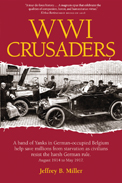
 |
WWI Crusaders: A Band of Yanks in German-Occupied Belgium Help Save Millions from Starvation as Civilians Resist the Harsh German Rule. August 1914 to May 1917
by Jeffrey B. Miller
Milbrown Press
As the First World War began to spread throughout Europe, Germany’s occupation of neutral Belgium struck many as a concerning action. With many of the able-bodied men shipped off for slave labor, the writing was on the wall that the country would stagnate and soon face a crippling food shortage. Efforts from within Belgium were being concocted to provide for the people, but without adequate access to resources and guarantees from the warring powers, nothing could be accomplished. Meanwhile, a group of Americans led by Herbert Hoover was helping American tourists out of the war zone but soon decided that intervention had to be taken in Belgium’s food crisis, as well. They had the protection as a neutral interventionist organization but lacked the infrastructure to disperse the aid appropriately.
This is the story of those two organizations: the Commission for Relief in Belgium and the Comité National de Secours et d’Alimentation. Though their prominent figures had bad blood between them, the survival of a nation depended on their cooperation as well as a number of outside factors. If the Americans lost their neutrality, the treaties that allowed them to move food into the country would fail. If the Belgians planned to subvert their German captors, trust that the aid carried no ulterior motives would deteriorate. With the bloodiest conflict the world had yet seen raging all around them, the CRB and the CN had to walk a tightrope if they wished to keep the Belgians fed in the midst of war.
Telling the entire history of these two organizations in one complete volume, the author has prepared this information in a way that the average reader should find pleasurable. Borrowing narrative constructs, Miller tends to follow the actions of the people involved in the day-to-day operations of the CRB and the CN rather than taking a bird’s-eye view of the situation. That is not to say that the story is dramatized or fictionalized. The book still aims at historical accuracy, meticulously sourcing its snippets of conversations and accounts of Belgium during World War I. What this accomplishes is something that is easier to read and follow along with for those that are interested in a fascinating story but not necessarily a textbook history lesson.
There are plenty of archival photographs and maps used throughout the book as visual aids to help the reader or highlight the principal people involved. The information covers the war up until America’s entry into the fight, as it created a situation where neutral aid could no longer be provided. The chapters are organized in a largely chronological fashion that allows the information to unfold in a natural way. The level of detail clearly conveys the author’s familiarity and expertise with the subject, but to present so much ground-level information in a way that reads naturally and keeps the pages turning exemplifies a mastery of storytelling and teaching. Readers with an interest in 20th-century history and the First World War, in particular, will find this humanitarian account fascinating, but the average reader will also be pleasantly pulled into a story of aid, intrigue, subterfuge, and an attempt to maintain humanity during a gruesome, drawn-out war.